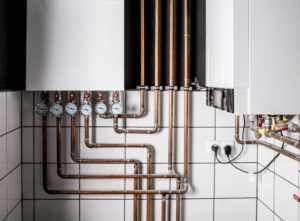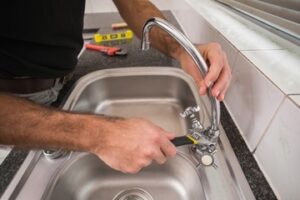Plumbers Dunwoody are on call 24/7 to fix the pipes that carry water and waste. Their duties range from repairing leaky faucets to re-piping an entire house. They are known for their manual dexterity and physical strength.
They also interpret blueprints, research regulations, and standards and install or repair a wide variety of fixtures. Plumbers must also have strong customer service skills to explain the work required and obtain customers’ approval for the quoted price.

The water supply system brings freshwater into the home and distributes it to fixtures. This includes the kitchen sink, bathroom shower and bathtub, washing machine, dishwasher, ice maker and more. A plumber can help you choose the right pipes and fittings, such as PVC or PEX, for your home. Then they can install and repair them. You’ll want to keep your home plumbing system in good shape to prevent water leaks and other problems.
The main water line runs from the water company’s meter to your house. Then it branches out to your supply pipes. The main line may also have a shutoff valve before or after the meter to control your water usage. Plumbers use different tools to inspect and work on water supply pipes, including video cameras, pipe cutters, flaring pliers, dies, hydraulic pumps and specialised pipe-joining tools.
Water pipes are usually made from plastic, iron or copper. Copper pipes are popular because they’re durable and don’t change the flavor of your home’s water. However, they’re expensive and require a lot of work to install. Plastic pipes are more affordable, but they can crack or corrode over time. They’re also not as flexible as metal pipes, so they can’t bend easily or fit into tight spaces.
The water lines in your home are under pressure from the water supply system, so they’re more likely to break or burst than drain pipes. Water supply pipes are also more vulnerable to freezing temperatures, so you’ll need to take extra steps to protect them. The most important thing to do is to have a basic understanding of your home’s water supply system and the approved materials for your plumbing pipes. This will help you spot any potential issues and deal with them competently in an emergency. For example, if you notice that your home’s water pressure has dropped significantly, it could indicate that one of your water supply pipes is leaking or blocked. A plumber will be able to fix this problem quickly and effectively. They’ll be able to identify the source of the issue, whether it’s a broken pipe or a faulty water meter.
Drainage is the process of removing water and waste matter from a property. It’s important for keeping your home safe and dry, protecting your foundations, landscaping and possessions from water damage and ensuring the health of your family. Plumbers are responsible for installing and maintaining drainage systems in homes and businesses. This includes repairing damaged drains and pipes, detecting and locating blockages, and providing regular maintenance to keep your drainage system working as it should.
Plumbing is a skilled trade that requires manual dexterity and coordination, as well as analytical thinking and problem-solving skills. It’s also a physically demanding job that involves lifting heavy objects and working in awkward positions. While some plumbing jobs can be done remotely, others require the plumber to be on-site to install or repair piping and fixtures. This can make it difficult to balance a work life with a family or other commitments.
The majority of a plumber’s work is focused on residential and commercial properties, though they may also be called to work on industrial sites or government facilities. These jobs tend to be more complex than standard plumbing services and may involve specialised equipment or large-scale projects. Plumbers working on these types of projects often need to consult with engineers and other tradespeople to ensure that the plumbing is installed correctly and meets all relevant regulations.
When it comes to identifying and solving plumbing issues, plumbers use a wide range of tools and techniques. These include using specialised drain cleaning equipment, such as augers and hydro jets; testing water pressure and flow rates; locating leaks; repairing or replacing damaged pipework; and installing new fixtures and appliances, such as toilets and showers. In some cases, plumbers may need to dig up and replace entire sections of piping.
For larger plumbing installations, plumbers typically work with builders and other construction professionals to create and lay out piping systems before the concrete is poured. This prep work can help ensure that the finished plumbing system is watertight and structurally sound. It can also save time and money in the long run by avoiding costly repairs later on.
One of the most common services plumbers provide is the installation of sink garbage disposal units. These handy appliances grind food waste and flush it into the plumbing system, where it’s broken down into smaller pieces that can be easily disposed of. Kitchen sink disposal units, such as the InSinkErator models, are easy for plumbers to install. Plumbers can also install bathroom garbage disposal units, known as macerators. These toilet and sink attachments break down food waste and transfer the particles into the main drain line using fast-rotating blades.
Although a garbage disposal unit can handle most types of food waste, it is not meant to take on stringy, fibrous foods like celery, asparagus, corn husks and banana peels, which can wrap around the unit’s blade and dull it. Cooking grease, coffee grounds and eggshells can also clog a disposal. Other no-nos include starchy foods like rice, potatoes and pasta, which expand in hot water. Fats, such as butter, shortening and lard, can also jam a disposal and cause foul odors.
Another way to avoid clogs and keep your disposal in good working order is to use it sparingly. Even traces of food left on plates after eating can cause the appliance to grind and jam. It’s also a good idea to run cold water as the disposal operates, which will help to dissolve any leftover grease and clean the blades and interior of the machine.
Many people are unaware that their plumbing system also handles sewage. A plumber can help you determine if your home is in need of a septic tank or sewer system, and install the necessary components if required. A septic tank is a large, underground tank that holds wastewater and solid waste until it’s pumped out and taken to a processing plant. The tank is usually made of reinforced concrete or fiberglass, and may be lined with an impermeable membrane to prevent contamination.
Alternatively, your home may be connected to the municipal sewer system, which takes wastewater and solid waste to a processing plant. This process removes contaminants such as phosphorus and nitrogen, then disinfects the remaining water before it’s discharged back into the environment. Plumbers can install pumps and other equipment to connect homes to the city sewer system.
Many buildings use a hot water tank or cylinder for providing hot water. Plumbers can install, repair, and service these systems. They can also make recommendations about the best type of system for a home or business based on usage requirements and cost. For example, a plumber might recommend a pressurized hot water system for homes or commercial premises that require high levels of hot water, as these offer significant energy and space savings over time compared to traditional tanks.
Plumbers can also help prevent scalding injuries by making sure that the temperature of the hot water flowing from a shower or tap is not too high. They can do this by ensuring that the hot water pipework is properly insulated. In addition, plumbers can install recirculation pumps in hot water systems to minimise heat loss and maximise energy efficiency. They can also advise about the EPA’s WaterSense new home specification, which can help households save up to 20% in water usage.

